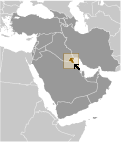World Atlas: Kuwait. On this page you can see the map, country flag and many detailed information about the people, history and economy of Kuwait.

Here you can find online selected information about the geography, inhabitants, government, economy and history of Kuwait. Included are selected statistics, an overview map and the detailed map of Kuwait. But let's start with the flag of Kuwait here:
Kuwait - Overview:
What you should know about Kuwait? Let's start with this: Kuwait has been ruled by the AL-Sabah dynasty since the 18th century. The threat of Ottoman invasion in 1899 prompted Amir Mubarak AL-Sabah to seek protection from Britain, ceding foreign and defense responsibility to Britain until 1961, when the country attained its independence. Kuwait was attacked and overrun by Iraq on 2 August 1990. Following several weeks of aerial bombardment, a US-led UN coalition began a ground assault on 23 February 1991 that liberated Kuwait in four days. Kuwait spent more than $5 billion to repair oil infrastructure damaged during 1990-91. The AL-Sabah family returned to power in 1991 and established one of the most independent legislatures in the Arab World. The country witnessed the historic election in 2009 of four women to its National Assembly. Amid the 2010-11 uprisings and protests across the Arab world, stateless Arabs, known as bidoon, staged small protests in early 2011 demanding citizenship, jobs, and other benefits available to Kuwaiti nationals. Youth activist groups' repeated rallies in 2011 for the dismissal of a prime minister seen as being corrupt, ultimately led to his resignation in late 2011. Demonstrations renewed in late 2012 in response to an Amiri decree amending the electoral law. The opposition, led by a coalition of Sunni Islamists, tribalists, some liberals, and myriad youth groups, largely boycotted legislative elections in 2012 and 2013, which ushered in a legislature more amenable to the government's agenda. However, the opposition, expressing strong opposition to the government’s fiscal reforms, participated in the November 2016 National Assembly election and won almost half of the positions. Since coming to power in 2006, the Amir has dissolved the National Assembly on seven occasions (the Constitutional Court annulled the Assembly in June 2012 and again in June 2013) and shuffled the cabinet over a dozen times, usually citing political stagnation and gridlock between the legislature and the government.
Geography of Kuwait
 Where on the globe is Kuwait? The location of this country is Middle East, bordering the Persian Gulf, between Iraq and Saudi Arabia. Total area of Kuwait is 17,818 sq km, of which 17,818 sq km is land. So this is quite a small country. How could we describe the terrain of the country? This way: flat to slightly undulating desert plain. The lowest point of Kuwait is Persian Gulf 0 m, the highest point 3.6 km W. of Al-Salmi Border Post 300 m. And the climate is dry desert; intensely hot summers; short, cool winters.
Where on the globe is Kuwait? The location of this country is Middle East, bordering the Persian Gulf, between Iraq and Saudi Arabia. Total area of Kuwait is 17,818 sq km, of which 17,818 sq km is land. So this is quite a small country. How could we describe the terrain of the country? This way: flat to slightly undulating desert plain. The lowest point of Kuwait is Persian Gulf 0 m, the highest point 3.6 km W. of Al-Salmi Border Post 300 m. And the climate is dry desert; intensely hot summers; short, cool winters.
Inhabitants of Kuwait
Let's take a look how many people live in Kuwait. The number is: 2,875,422 (July 2017 est.). So this is not very populous country. Who lives here? Kuwaiti 31.3%, other Arab 27.9%, Asian 37.8%, African 1.9%, other 1.1% (includes European, North American, South American, and Australian) (2013 est.). What are the languages in Kuwait? Arabic (official), English widely spoken. And the religions: Muslim (official) 76.7%, Christian 17.3%, other and unspecified 5.9%. How old are the people in average? 29.3 years. We have to add that this number is the median - so one half of the people is older than this, one half is younger. And what is their life expectancy (at birth)? This: 78.2 years. Where the people live in Kuwait? Here: densest settlement is along the Persian Gulf, particularly in Kuwait City and on Bubiyan Island; significant population threads extend south and west along highways that radiate from the capital, particularly in the southern half of the country. The major urban areas of Kuwait are: Kuwait (capital) 2.779 million (2015).
Government and Economy of Kuwait
The capital of Kuwait is Kuwait City and the government type constitutional monarchy. Let's take a look at the administrative divisions - 6 governorates (muhafazat, singular - muhafazah); Al Ahmadi, Al 'Asimah, Al Farwaniyah, Al Jahra', Hawalli, Mubarak al Kabi. Regarding the economy of Kuwait, important industrial products are petroleum, petrochemicals, cement, shipbuilding and repair, water desalination, food processing, construction materials. Important agricultural products are fish. The most important export commodities are oil and refined products, fertilizers and the most important export partners are South Korea 16.8%, China 14.4%, Japan 9.6%, India 9.2%, US 7.5%, Singapore 5.6% (2016). The most important import commodities are food, construction materials, vehicles and parts, clothing and the most important import partners are China 14.1%, US 11.9%, UAE 8.3%, Japan 6.5%, Germany 6.2%, India 5.4%, Italy 5%, Saudi Arabia 4.4%, South Korea 4.4% (2016). How rich is Kuwait and how rich are people in this country? The most important number here is GDP per capita (PPP): $69,700 (2017 est.). This means the people are rich on average here. Let's add that this means Gross Domestic Product per person, which is recalculated with respect to the relative cost of local goods and services. And one more important number - population below poverty line: NA%.